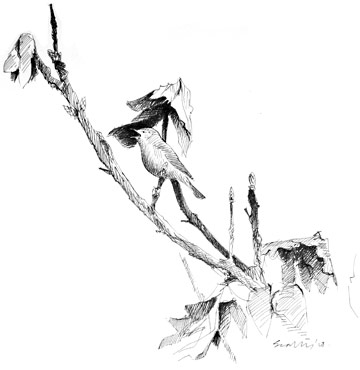Garden Warbler (Sylvia borin)

Garden Warbler © Ray Scally
The relationship of Garden Warbler to Blackcap is similar to that of Willow Warbler to Chiffchaff; in each pairing, the former is a long-distance migrant, breeding here in scrub habitats and woodland edges while the latter is a shorter-distance migrant, breeding in mature woodlands. Their fortunes are aligned as well, with Blackcap and Chiffchaff increasing greatly in the last twenty years whilst Garden and Willow Warblers are in decline.
However, the substantial fall since our First Atlas in the number of tetrads occupied by Garden Warbler – a net loss of 46 tetrads – came as a surprise, as there had been no suggestion, in Cheshire and Wirral annual bird reports, of any change in status. The ‘change’ map shows a widespread scatter of gains and losses across the county, with no particular pattern, and there is no obvious explanation.
The National Atlas (1988-91), surveying on a 10km2 grid, found Garden Warblers at their highest densities in Wales and southern England, but missing, or present only at low densities, in much of Wirral, north Cheshire, Merseyside, Lancashire and Greater Manchester. This picture can be amplified at a regional level by examining the figures from the tetrad atlases of nearby counties. The species was reported from 45% of tetrads in our First Atlas, and in 37% of tetrads in this survey. Records came from 74% of tetrads in Shropshire (1985-1990) and 32% in Lancashire and North Merseyside (1997-2000). Looking in greater detail, there are clear gradations within those counties. In Shropshire Garden Warblers were found in 58% of the northernmost one-third of the county, nearest to Cheshire, and 82% of the rest. Within Lancashire and North Merseyside, they were recorded in just 25% of the tetrads south of the Ribble, but 43% north of the Ribble, the same figure as in the whole of Cumbria (1997-2001). A clear picture thus emerges of relative scarcity in Cheshire and Wirral, and parts of adjoining counties; this is also suggested by the map of relative abundance produced by the BTO from the national 2003 BBS returns.
All of this is, of course, a description of the Garden Warbler’s distribution but not an explanation for it; neither does it account for the drop in occupied tetrads in the county since the First Atlas. There are several factors probably affecting them: habitat loss on the breeding grounds; competition with other species; and climatic changes, at any point in their life-cycle. Scrub is in decline as a British habitat, following reduced woodland planting and management, and there are fewer of their favoured young, open woodlands with internal rides (Rackham 2006). This is an inappropriately-named species for modern Britain, and only the largest and most overgrown gardens might hold a pair. On top of unfavourable habitat change, Garden Warblers could be losing out in competition with Blackcaps. Blackcaps dominate interspecific competition, and arrive here increasingly earlier in spring such that – based on the BTO’s national figures – their breeding cycle is now almost two weeks ahead of that of Garden Warblers; twenty years ago, there was only about three days’ difference. Typical hatching dates for Cheshire are in the first week of June. Climate change could also be adversely shifting the synchronicity between Garden Warblers and availability of their favoured food items, as has been demonstrated for several species (Visser & Both 2005). During the breeding season they feed themselves and their young on caterpillars of the smaller moths and butterflies, as well as small beetles, Diptera, Hymenoptera, Hemiptera including aphids as well as spiders, and occasionally small worms (Simms 1985).
They winter in west Africa, ringed British birds especially being found in Ghana. There is no evidence that their population has fluctuated in line with the Sahelian droughts, and Garden Warblers appear to survive the winter well, having one of the lowest annual mortality rates of any migratory passerine. This balances their low productivity. They have the smallest broods of the common species in the Sylvia family, with three or four chicks. Most nests are low down, typically 0.5 m above ground, in a bush – bramble being their favourite – or in nettles (Mason 1995).
The present national population is somewhat higher than it was during the seven-year period of fieldwork for our First Atlas, making the local contraction in distribution more puzzling. The BTO analysis of 2004-05 BBS data puts the breeding population of Cheshire and Wirral as 3,000 birds (with wide confidence limits from zero to 6,070), corresponding to an average of about 39 birds per tetrad with confirmed or probable breeding, or 12 birds per tetrad in which the species was recorded.
Sponsored by John Headon

